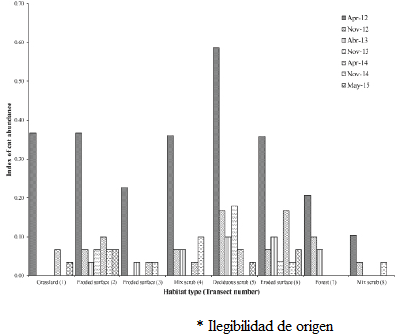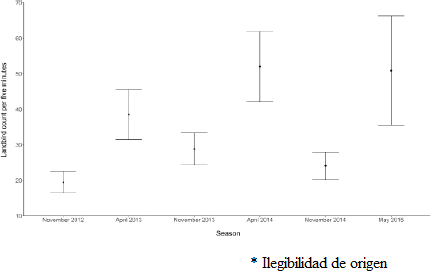Introduction
The islands of Mexico are recognized worldwide for their high biodiversity, since these host a large number of endemic species (Aguirre-Muñoz et al. 2005; 2011; 2016). However, many islands in Mexico and around the world have experienced severe impacts resulting from human activities (Johnson and Stattersfield 1990; Chapuis et al. 1994; Algar et al. 2004; Bonnaud et al. 2011). Approximately 75 % of animal extinctions have occurred in islands, mainly because of introduced species (Ebenhard 1988; Diamond 1989; Groombridge 1992). Alien species are the main cause of biodiversity loss and ecological imbalance in many environments (Chapuis et al. 1994; Moro 1997; Bonnaud et al. 2011). In Mexico, cats were introduced into at least 34 islands, causing serious impacts on the native fauna and contributing to the disappearance of seabirds and the confirmed extinction of 17 species of birds and mammals in Mexican islands (Aguirre-Muñoz et al. 2011; 2016). In Guadalupe Island, for example, the feral cat has been responsible for the extinction of endemic species such as the birds Guadalupe Bewick’s wren (Thyromanes bewickii brevicauda) and the Guadalupe towhee (Pipilo maculatus consobrinus), in addition to posing a risk for seabird populations, including the likely extinction of the Guadalupe storm petrel (Hernández-Montoya et al. 2014).
In the case of Socorro Island, the feral sheep (Ovis aries), the feral cat (Felis catus) and the domestic mouse (Mus musculus) have caused significant negative impacts on the ecosystem. The feral sheep was responsible for soil erosion, loss of vegetation cover and habitat modification (Levin and Moran 1989; Alvarez-Cárdenas et al. 1994; León de la Luz et al. 1994; Maya Delgado et al. 1994; Brattstrom 2015), which led to negative impacts on the native fauna (Martínez-Gomez et al. 2001). For its part, the feral cat, introduced into the island in the 1950s, poses a serious threat for the local vertebrate populations. Predation by cats threatens the persistence of native species, particularly those of small population size, such as the Socorro tree lizard (Urosaurus auriculatus; Arnaud et al. 1993; 1994). Likewise, feral cats contributed to the extinction in the wild of the Socorro dove (Zenaida graysoni) and the Socorro elf owl (Micrathene whitneyi graysoni), and has also led to other species being listed as endangered of extinction, as is the case of the Socorro mockingbird (Mimus graysoni) and the Townsend´s shearwater (Puffinus auricularis; Martinez-Gomez and Jacobsen 2004).
Achieving the recovery of both the habitat and native species requires the eradication of the introduced species (Veitch and Clout 2002; Aguirre-Muñoz et al. 2005; Veitch et al. 2011;Jones et al. 2016). Given the threats that Socorro Island currently faces, from 2009 to 2012 the Mexican environmental organization named Grupo de Ecología y Conservación de Islas, A. C. (GECI) undertook the eradication of the feral sheep that has led to a remarkable homeostatic environmental recovery (Ortiz-Alcaraz et al. 2016a; 2016b). The eradication of the feral cat represented another serious challenge, since Socorro is a large and complex island, and little baseline information was available on the distribution and abundance of this species (Arnaud et al. 1994). Fortunately, technologies have been developed in islands in Mexico and worldwide for the eradication of feline predators (Bester et al.2002; Wood et al. 2002; Algar et al. 2010; Aguirre-Muñoz et al. 2011; Luna-Mendoza et al. 2011; Parkes et al. 2014). For the successful implementation of an eradication campaign of this type, is essential to determine the ecology of the species, assess the impact of the applied methods on the native fauna, and to develop an executive eradication plan (Veitch 1989; Arnaud et al. 1994; Donlan et al. 2003; Dowding et al. 2009). Given the imminent risk that predation by cats posses to the island’s endemic species, there was an urgent need to execute a control program that would provide information about the biology of this predator. Thus, an intensive monitoring program of feral cats in Socorro Island was launched in 2000, aimed at achieving its eradication. This work describes the methods used, the progress achieved between 2011 and 2015, and the preliminary results of the recovery of native fauna after the implementation of erradication efforts.
Materials and Methods
Study area. Socorro Island is a federal territory that belongs to the Revillagigedo Archipelago. It is located 460 km south of Cabo San Lucas, Baja California Sur, and 694 km west of Manzanillo, Colima (18.7833° N, -110.9666° W, Figure 1). It comprises an area of 132 km2 with a maximum altitude of 1,050 m. The island is home to 117 species of vascular plants, 30 of which are endemic (León de la Luz et al. 1994). The fauna of Socorro Island includes 103 species of terrestrial birds, eight species of which are endemic, seabirds and one endemic reptile, the Socorro Island tree lizard, endemic to the island. In addition, Socorro Island is the only nesting site of the Townsend´s shearwater, a seabird endemic to the archipelago. The island is permanently inhabited by 50 soldiers of Mexico’s Secretariat of the Navy (SEMAR, for its acronym in Spanish), which has a Naval Sector in the southeastern end of the island (CONANP 2004).
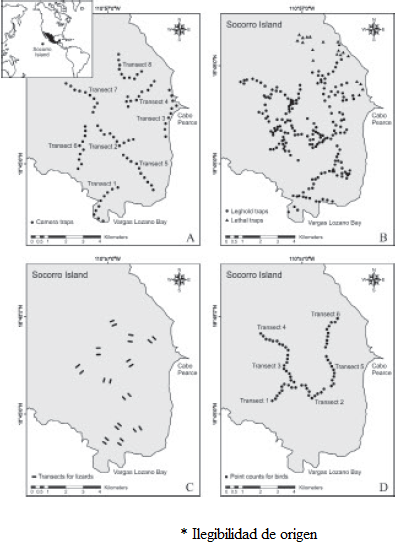
Figure 1 Location of A) transects of odor stations for monitoring feral cats through camera traps. B) Leg-hold trap (circles) and lethal traps (triangles) for the control of feral cats. C) transects for monitoring the Socorro Island tree lizard. D) Count-point transects for monitoring terrestrial birds.
Feral cat monitoring and control. The relative abundance of cats was estimated using camera traps. During April-May and November of 2011 to 2015 (two annual monitoring events, one for each season), eight transects with camera traps were set (Bushnell Trophy cam HD Agressor). Each transect ran across 3 km and included a total of 10 camera traps with a 300-m separation between them (Figure 1A). Cameras were installed at a height of approximately 50 cm from the ground, slightly tilted downwards, and were set to take a sequence of five photographs per minute when motion was detected. A commercial cat bait made of seafood was used (Shellfish, Tomahawk Live Trap). Cameras remained active for three consecutive nights, representing an effort of 240 trap-nights in each biannual monitoring. The relative abundance index was calculated as the total number of visits (animals individually identified according to distinctive traits through photographs), divided by the total number of trap-nights.
According to Arnaud et al. (1994), cats are located mainly in the eastern area of the island; therefore, it was decided to concentrate the initial catch effort in that area. The control method consisted mainly in catching cats using leg-hold traps (Oneida Victor Soft Catch #1 ½) and lethal traps (Conibear Bodygrip Traps 10”), according to the experience in other islands in Mexico and worldwide (Rauzon 1985; Twyford et al. 2000; Phillips et al. 2005; Rodríguez et al. 2006; Rauzon et al. 2008; Luna-Mendoza et al. 2011). Leg-hold traps including pads were placed to fulfill good humanitarian practices (NOM033-ZOO-1995) in 220 sites (Figure 1B) over the duration of the expedition (21 to 51 days), and baited with a commercial cat bait made of seafood, tuna or fried sardine (Brothers 1982). Traps were reviewed daily from 7:00 to 10:00 h. Lethal and leghold traps located in hard-to-access sites were equipped with telemetry systems (ATS, mammal trap monitor Series M4000) to determine whether they had been activated from a distance (Will et al. 2010). Once cats were captured, these were euthanized by intramuscular injection of an anesthetic (Zoletil 50, Laboratories VIRBAC Mexico) and a lethal intracardiac injection (pentobarbitol), also following humanitarian euthanasia best practice guidelines (NOM-033-ZOO-1995). As a secondary method, night hunting was conducted using 0.222 caliber and 0.22 rifles with telescopic sights and lamps (Kohree 80,000 lux). The capture success was estimated with the formula e = (cats captured/trap-nights) x 100.
Monitoring of native fauna. Since cats predate mainly on domestic mice, tree lizards and terrestrial birds (Arnaud et al. 1993; 1994), it was necessary to carry out a monitoring of the native species to determine and document any changes resulting from the control of the feral cat in Socorro Island. The Socorro Island tree lizard was monitored during April-May and October (two seasons per year) from 2012 to 2015. Twenty four transects were set (Aguirre-León 2011) in three different types of habitat (eight transects per habitat type): forest, deciduous scrubland and eroded areas or areas impacted by sheep (devoid of vegetation, León de la Luz et al. 1994), each measuring 6 m wide by 100 m long (Figure 1C). Transects were visited during three consecutive days in each biannual monitoring, between 10:00 and 12:00 h. Density was estimated using the following formula: D = (n/2wL).
Where n is the number of individuals counted, L is total transect length, and w is the width of the transect (Gallina and López-González 2011). A one-way repeated measures analysis of variance (rANOVA) was conducted to determine the effect of the season and habitat type on tree lizard density. The statistical software R version 3.2.2 was used.
Terrestrial birds were monitored using the point-count technique (González-García 2011). Six transects were established in the island during April-May and October (two seasons per year) from 2012 to 2015 (Figure 1D). The monitoring was carried out from 6:30 to 9:30 h and was repeated on three consecutive days in each biannual season. At each site, all birds observed within a radius of 25 m during five minutes were counted. Subsequently, the observer moved to the next counting point located 250 m away, with a five-minute break before starting the next count. The statistical test rANOVA was run to determine the effect of season and habitat type on the total number of birds, plus Student t-tests for paired samples with a Bonferroni adjustment, to compare sightings during the different seasons.
Results
Feral cat monitoring and control. Camera trapping was used to determine the relative abundance of cats in the various zones of the eastern part of the island, as well as to guide capture efforts. In 2012, cats were found in all the sites studied; their abundance was higher toward the southeast (close to the Naval Sector), and lower in the northern zone and in the areas with the highest altitude (1,050 masl) in the central part of the island. As the cat control program progressed, the abundance of cats decreased drastically. By May 2015, cats were located only in transects recorded in the southernmost areas of the island (Figure 2). It was also noted that a lower number of cats in the entire island was observed as the monitoring seasons progressed. The success of cat capture during the trapping activities fluctuated throughout the year. However, a clear trend toward a smaller population was noted on a multi-year timescale (Figure 3). In general terms, the success of capture is greater in the dry season, and decreases during the rainy season (Table 1). Eight cats were dispatched by night hunting, to recover GPS collars; these specimens were not considered in the table of capture success.
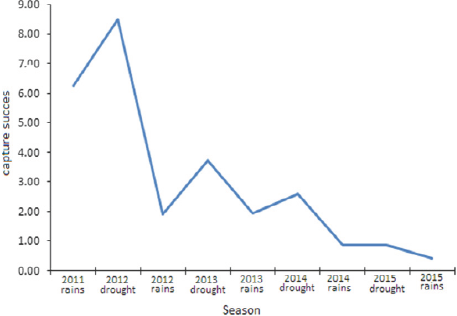
Figure 3 Reduction in the capture success (%) of feral cats in the rainy and dry seasons from 2012 to 2015.
Table 1 Trap-nights, cats killed and capture success of feral cats in Socorro Island in the dry and rainy seasons from 2011 to 2015.
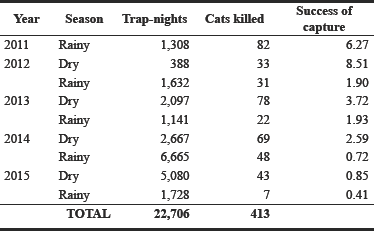
Monitoring of native fauna. The results of tree lizard monitoring reveal that the population is increasing, considering both the dry and rainy seasons (Figure 4). Lizard density fluctuated significantly between seasons since the trapping of cats started in Socorro Island, F(6.12) = 4.4, p = 0.014.
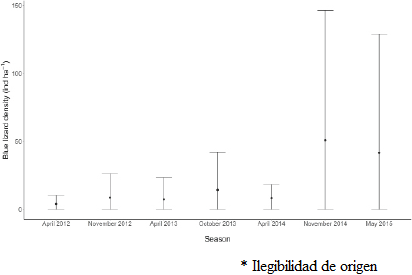
Figure 4 Mean density of the Socorro Island tree lizard (Urosaurus auriculatus), with confidence intervals, for the dry and rainy seasons from 2011 to 2015 in Socorro Island.
The number of birds sighted from 2012 to 2015 also showed significant differences between seasons, F(5.96) = 5.36, P = 2.2 × 10-4. Although a population fluctuation is evident over the years of the study, there is an increase in the dry seasons of 2014 and 2015 (Table 2, Figure 5). Significant differences were found between November 2012 (study start-up and time point next to the eradication program start-up) and the rest of the monitoring monitoring times (except November 2014). No significant differences were found between dry seasons during the years 2013 to 2015. The most abundant species was the Socorro warbler (Setophaga pitiayumi graysoni), followed by the Socorro wren (Troglodytes sissonii), and the towhee (Pipilo maculatus socorrensis), all of them endemic to the island (Figure 5).
Table 2 Sample size (N) of each season, average and standard deviation (SD) of the total number of birds for each season and its corresponding confidence interval (CI) for the average number of birds along 6 transects, with a confidence level of 95 %.
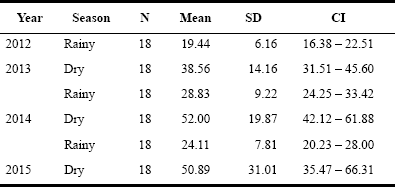
Discussion
A study to determine the home range of cats conducted in 2013 (Ortiz-Alcaraz, unpublished data), where necklaces fitted with GPS/VHF (Sirtrack Mod. G2C 128aWGPS 170 to 230 mm Necklace) were placed to six animals, revealed a mean home range of 2.19 km2 for males and 1.18 km2 for females. Based on this information and the experience in other Mexican islands (Luna-Mendoza et al. 2011), it was determined that traps should be separated by 300-500 meters to ensure that animals encounter at least one trap during their foraging movements.
Monitoring feral cat has served to adjust the trap-placement effort in the eastern part of the island, where they are most abundant (Arnaud et al. 1994). The trapping effort should continue in order to catch the cats moving from one area to another. The capture of cats increases during the dry season (December to May) and decreases in the rainy season (June to November). These findings are not related to the abundance of cats, but are a sampling artifact, since moist land interferes with the installation of leg-hold traps, dry substrate to cover them is unavailable while rain compacts and hardens the substrate covering the traps impeding their activation. At the same time, another key factor that affects trapping in the rainy season is the higher abundance of land crabs (Gecarcinus planatus), which either consume the baits placed in traps or activate traps when attempting to reach the bait. Crabs are not caught in traps because they reach the bait from the back of the trap, but traps are nonetheless activated due to the crab's foraging activity. The combination of lethal traps and telemetry devices is essential during trapping in the most remote areas of the island. In this way, traps do not have to be checked daily but every five to seven days to replenish any bait lost to insects (mainly ants) and crabs (Parkes et al. 2012).
The Socorro Island tree lizard was found at higher densities in the deciduous scrubland, being less abundant in forests at higher altitudes. The results of this study show that the density of lizards in eroded surfaces was as high as 43 individuals/ha after cat was controlled, while Gallina-Tessaro et al. 1994 reported not having observed lizards in these areas. This may be due to a gradual recovery of the vegetation resulting from the recent eradication of sheep (Ortiz-Alcaraz et al. 2016a; 2016b) and to the sustained trapping of cats in these areas. Lizard density was slightly higher during the rainy season, likely due to a higher food availability. As the cat control program in the eastern area of the island has progressed, the predation pressure of cats on the lizard population has decreased. Lizards are a major component of the cat’s diet (50 % of fecal samples of cats analyzed contained lizard remains; Arnaud et al.1993).
The whighest number of birds was observed was the forest (Ficus - Guettarda - Ilex) vegetation type, especially in the highest parts of the island, where the recovery of vegetation resulting from the absence of grazing after sheep were eliminated has led to a greater availability of food and shelter against predators (Rodríguez-Estrella et al. 1994). Special efforts have been made to control cats in the forest, aiming to protect the native bird species such as the Townsend's shearwater (Ratcliffe et al. 2009). In 2015, a lower number of birds were watched relative to 2014 in eroded areas, Ficus (amate) forests and mixed shrubland. It is considered that the reduction is due to the visual interference of vegetation, as these areas had been previously eroded and subsequently colonized by shrub speceies such as Hyptis pectinata (up to 2.5 m height), Dodonaea viscose and the common fern (Pteridium caudatum). Additionally, to the above, cats are still present in these habitats, likely because of the considerable coverage provided by this type of vegetation. The eradication of feral cat and the monitoring of the native fauna should continue, in order to confirm recovery and to increase of the population size of the native fauna.
The plans developed by Veitch (1989), Arnaud et al. (1993) and Parkes et al. (2012) agree in that feral cat can be eradicated using traditional techniques: trapping and night hunting. However, the experience in the island has highlighted the importance of using detection dogs to locate the remaining cats, either during the day, in their dens (providing an opportunity to set traps), or at night where cats may be killed by night hunting (Tortora 1982; Veitch 2001), as well as for the statistical confirmation of cat absence during the final stage of an eradication campaign (Ramsey et al. 2011).
As the eradication of feral cat in Socorro Island progresses, the populations of native vertebrates are recovering, as has happened in other islands (Rodriguez-Moreno et al. 2007; Aguirre-Muñoz et al. 2011). Once the absence of the cat in the island is confirmed statistically, the essential conditions for the successful reintroduction of the Socorro dove, - a species currently extinct in the wild and preserved in captivity only -will be established (Yanga et al. 2011).











 text new page (beta)
text new page (beta)

